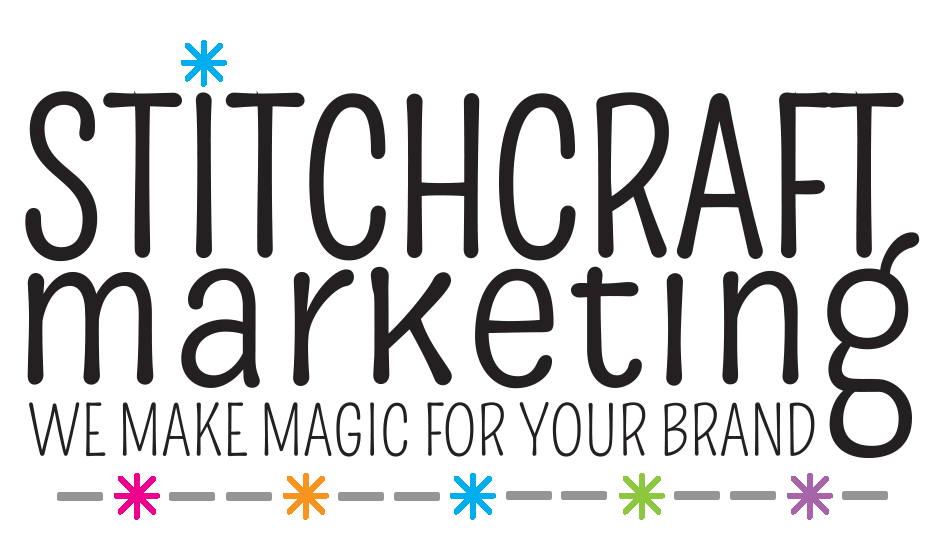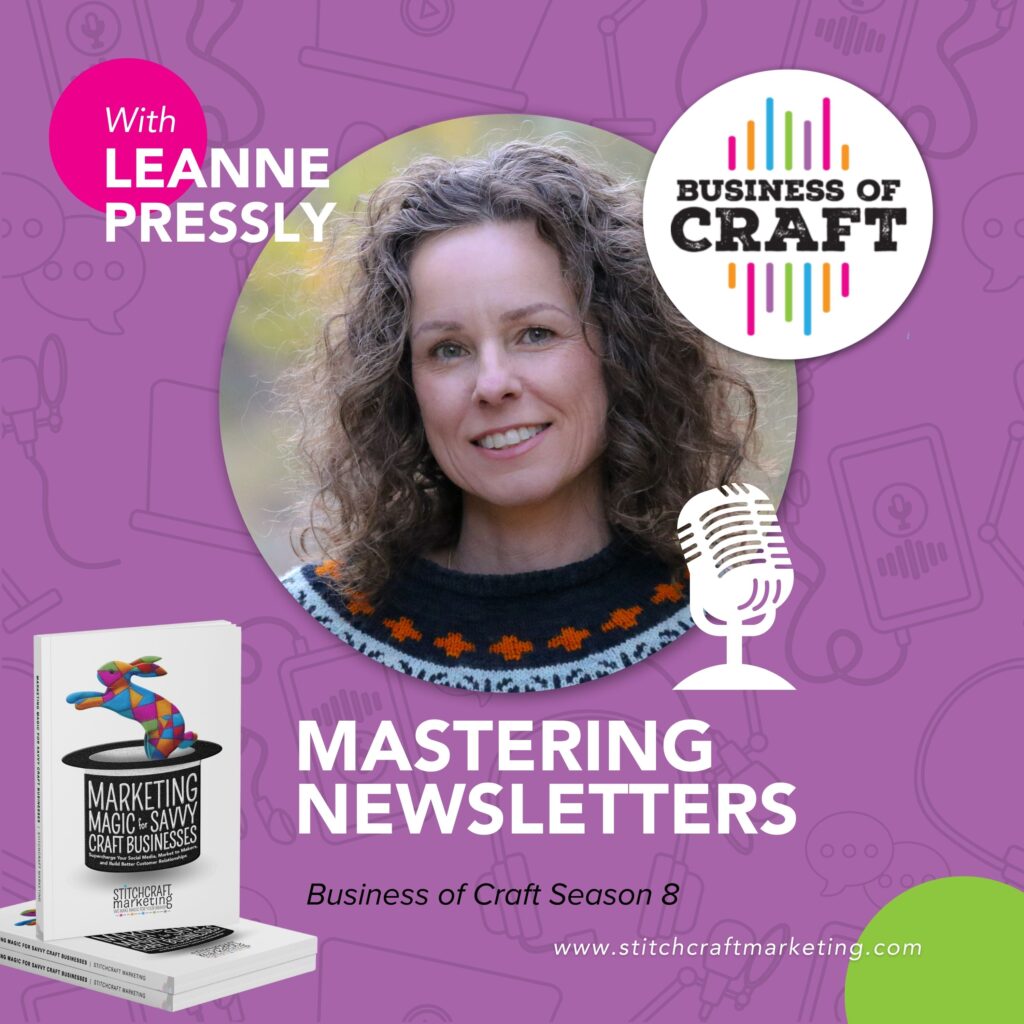WELCOME TO SEASON 8 OF BUSINESS OF CRAFT
Welcome to Business of Craft, a show designed to help entrepreneurs with fabric or fiber businesses become more successful.
This is our 8th season of BOC and today we have another solocast to cover one of the topics in our new book, Marketing Magic for Savvy Craft Businesses. I’m super proud of this book which my whole team wrote in 2025. The book is available for sale in Kindle and print version (and soon to be audio) on our website or Amazon.
Listen to the Show:
Listen to it on Spotify, iHeartRadio, iTunes, and PlayerFM, or catch the video version on YouTube.
Thank you for taking the time to listen! If you’re enjoying the show, it’s safe to assume there are others out there like you who would also enjoy the show. Help them find it by leaving a review on your favorite podcast platform. Don’t forget to subscribe to stay on top of the latest episodes!
Today we’re talking about the topic in chapter 11 of our book, Marketing Magic for Savvy Craft Businesses: Mastering Email Newsletters for Deeper Engagement.
Let’s start with a quick bit of marketing magic vocabulary: Pull vs. Push Marketing.
Your social media posts, blogs, and SEO strategies? Those are Pull tactics. You’re trying to attract people to come find you. But a newsletter? That’s Push. You’re nudging your customer to pay attention—with their permission.
And here’s where the magic really happens: A newsletter lets you bypass the algorithm and connect directly with the people who have already told you they want to hear from you.
That’s incredibly powerful. That’s what we call permission based marketing.
In fact, from Stitchcraft Marketing’s Craft Retailer Survey— our proprietary research that we did in 2023, 46% of craft retailers report that newsletters are an effective revenue driver—yet many still don’t prioritize this tool.
Next we need to talk about how to build your list THE RIGHT WAY.
Let’s be clear—building your email list isn’t a “set-it-and-forget-it” task. Growing your list requires intention. Make it easy for customers to subscribe, and promote your signup form across all your touchpoints: website, social, in-store signage, and events.
And don’t forget to collect more than just names and emails. If you can capture birthdays, purchase history, or interests, you open the door to personalization—which we’ll get into in just a moment.
You CAN include existing customers if you’ve got a POS system and collected emails.
Now, I need to say a little bit about the Can Spam laws– you cannot– and Repeat, you cannot just go grab a list somewhere (or buy a list from a third party vendor) and start sending them newsletters. This is going to be the fastest way to lose trust among potential customers. AND a lot of email platforms will catch this and ban you… which we definitely don’t want.
We all know inboxes are crowded. So how do you make your newsletter irresistible?
It starts with VALUE. Each email should educate, entertain, or promote—and the best newsletters mix all three. Keep it juicy. Balance product info with your highest quality content—like tutorials, stories, community highlights, or tips.
Here’s a golden rule: Don’t be too long. Don’t be too short. Don’t be too salesy. Don’t be too chatty. Your content should be just right—relevant, visually appealing, easy to navigate, and mobile optimized.
Remember all our lessons on generosity marketing. Here is where that applies.
TIP: Send your newsletter from a person at your company—not just a brand name. People connect with people. A friendly note from “Sharon at YarnCraft Co.” will feel warmer and more trustworthy than something from “info@yarncraftco.com.”
Also, a reminder that this content should NOT be the same as what’s on your blog or searchable on your website somewhere. This is the extra special juicy stuff!
Email segmentation is another layer of personalization that makes your emails land.
Segment by:
- Interests or Avatar groups (like knitters vs. crocheters)
- Past purchases or class participation
- Location, for promoting in-person events or regional specials
Segmentation increases relevance, and relevance increases clicks.
Once you’ve nailed your newsletter basics, it’s time to bring in some automation magic.
Start with a Welcome Sequence. This is an automated series of emails that greet new subscribers, share your brand story, showcase your products, and offer any signup incentive you promised. Research shows 74% of subscribers expect a welcome email—and that welcome emails get 100-400% more opens than regular emails.
That’s too powerful to ignore.
Other automation ideas include:
- Birthday emails
- Order confirmations
- Abandoned cart reminders
- Blog post alerts
- Product recommendations
Once set up, these run in the background—nurturing customers while you sleep.
Don’t just look at open rates. Thanks to changes like Apple Mail Privacy Protection, open rates are no longer a reliable metric on their own.
If your unsubscribe rate climbs above 7%, you may need to refine your content or your segmentation. And if your bounce rate rises above 30%, your email list may need a good cleaning.
And don’t forget—A/B testing is your friend. Try out different subject lines, send times, or formats. See what resonates, and iterate.
Here’s your rapid-fire checklist:
- ✅ Catchy subject line
- ✅ Clear sections with headers
- ✅ Valuable, balanced content
- ✅ Visual appeal (but don’t rely on images alone)
- ✅ Mobile-friendly design
- ✅ Strong CTA
- ✅ Unsubscribe link
- ✅ Social media links
- ✅ Tracked links (use those UTMs!)
- ✅ Proofread—always!
Newsletters are more than marketing—they’re relationship builders.
Start simple. Be consistent. Show up like a friend who brings value every time they visit.
And if you’re feeling overwhelmed? Break the task down. Write an outline. Use AI tools like ChatGPT to brainstorm ideas or generate a first draft—but remember, AI isn’t perfect. It can help you get started, but the heart and humanity of your brand still needs to come from you. That personal, human touch is what makes your content feel magical—and authentic.


